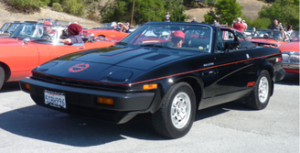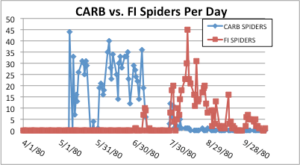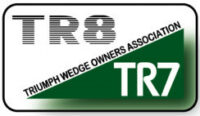
Counting TR7 Spiders: A Day at the Gaydon Archive

As the owner of a 1980 TR7 DHC EFI Spider Special Edition, I have wondered how many of these cars were built. Variously listed in previous write-ups as 1050 to 1250, I decided to spend a day in the Archive room at the British Heritage Motor Centre in Gaydon, Warwickshire during my last visit to the U.K. this April to establish the definitive number. Armed with paper and pencils, I arrived close to the opening time - my task to go through every 1980 Solihull factory Wedge build card (all 1,918 of them) to conclusively determine the TR7 Spider Special Edition count.
The Triumph TR7 Spider Special Edition was characterized by black paint (documented as both black & maraschino), red Spider decals, cast alloy wheels, black door trim, grey striped seats, leather steering wheel, 5-speed manual transmission and a radio/cassette player (though this was not fitted by the factory) Contrary to other sources, ALL the Spider accessory / package items were factory installed (figure 2). The radio/ cassette player was shipped in the boot of the vehicle, and installed at the port of entry(3).
Presented with two large boxes of dusty tattered cards, I set to work, with a tight schedule, for I wanted to re-visit the car collection too, and find time for a nice cuppa in the excellent onsite restaurant.
Some hours later, after sifting through these original factory build cards, watching the typing and handwriting change from month to month, studying arcane data such as seat colours, I was finally done, pencils worn down, paper spread about and pages of data collated for later analysis.
So, you ask, what was the outcome? I now know exactly how many TR7 Spiders were built, the days they left the factory and much more besides.
The final counts
In 1980, Triumph transferred production of the TR7/8 from Canley to the Solihull Jaguar-Rover-Triumph factory. Rover SD1’s and TR7’s were to be built in a (short-lived) purpose-built extension. An overlap period with Canley of 6 months allowed a slow ramp of the Solihull line. For these six months (April 1st to October 15th);
- A total of just 1,898 – 1,918 [1] cars were built;
- All were LHD TR7 DHC 5-speed manual transmission cars for the US market (VIN starts with TPVD8JAA or TPZDJ8AA)
- The first 300 (VIN 400001 to 400300) were mixed paint & trim colours with steel wheels (i.e. not Spider special editions), all were Carb cars (VIN TPVDJ8AA)
Why the range of numbers here? – 20 build cards from the early carbureted car sequence are missing from the Archive. Unless these can be tracked down, the final count will remain this imprecise. If you know of one of these VIN numbers, do let me know.
How many Spiders then?
- The remaining 1,618 [2] [6] cars (VIN 400301 - 401918) were Spider special editions
- 1,070 [3] were Carbureted Spiders (VIN TPVDJ8AA)
- 548 [4] were Fuel Injected Spiders for the California market (VIN TPZDJ8AA)
A few other random statistics
- The most cars built in a day was 48 (less than the new Mini factory turns out in one hour today).
- The factory worked five days a week, with shutdowns at Easter and in the summer. 12 cars were supposedly completed on weekends and holidays (likely just date stamp errors?); it seems the factory worked on the late summer Bank Holiday (Aug 25th, 1980), the union must have negotiated special pay that day!
- Cars were completed in relatively random VIN sequence, several reasons exist: some cars likely were sent to ‘rectification’ for faults to be corrected before shipping; others were stored before shipping, etc.
- The first one-off FI car VIN 401225 was built on July 1st. The production switch-over from Carb to FI cars occurred at the summer shutdown July 13th – 28th,, although a few Carb cars were completed after this date (trickling through the line as components were used up perhaps?).
- Build cards were printed (yes BL did have computers then!) in batches, many were perhaps originally intended for the Canley line & have paint colors and trim details whited-out with the Spider details handwritten in. The build cards contain many obvious errors, yet the Spider count is clear when cross-checked against the Spider Registry created by John Manske. Occasional handwritten cards & substitutes are included in the Archive.
If you have a TR7 Spider and have information to add or would like to know the exact date of manufacture, please contact me, Michael Hart - mjhart853@gmail.com
Copyright ©2013, Triumph Wedge Owners Association, all rights reserved

Notes
[1]. 1,898 Cars counted from the 1,918 VIN number sequence. 20 build cards are missing;
401121, 401139, 401141, 401142, 410146, 401178, 401179, 401211, 401216, 401271 – 401276, 401283, 401284, 401289, 401294, 401297. All missing cars are from the Carb sequence.
[2]. Total Spider count could be as high as 1,608 with the missing build cards.
[3]. As many as 1,070 Carbureted Spiders (see notes 1 & 2).
[4]. Perhaps 1 more Spider VIN 401160. Hand-marked as FI, but w/ Carb Engine number.
[5]. EFI Spiders use the Bosch fuel injection system and were built for the California market where stricter emissions regulations were put in place for the 1980 model year, cutting the allowed CO & NOx emissions levels progressively towards 1982 new standards. Federal regulations trailed California by several years, largely due to stalling by Chrysler (ref 1). In 1981, all Wedges converted over to EFI, adding an EPA estimated $1,000 to the manufacturing cost and making the selling price even less attractive, though waivers were issued for some years to many American cars by the EPA.
[6] Missing build cards referenced to actual documented vehicles - see page TR7 Limited Edition
References
1. ‘Effect of Emissions Regulation on Vehicle Attributes, Cost, and Price’, Belinda Chen, prepared for the CARB and CEPA
2. Jaguar Rover Triumph Collision Guide (fig 3)
3. Discussions with Michael Cook, Jaguar Rover Triumph North American Competitions Department
4. Originally published in the newsletter of the Triumph Wedge Owners Association, issue 23, July 5, 2013

